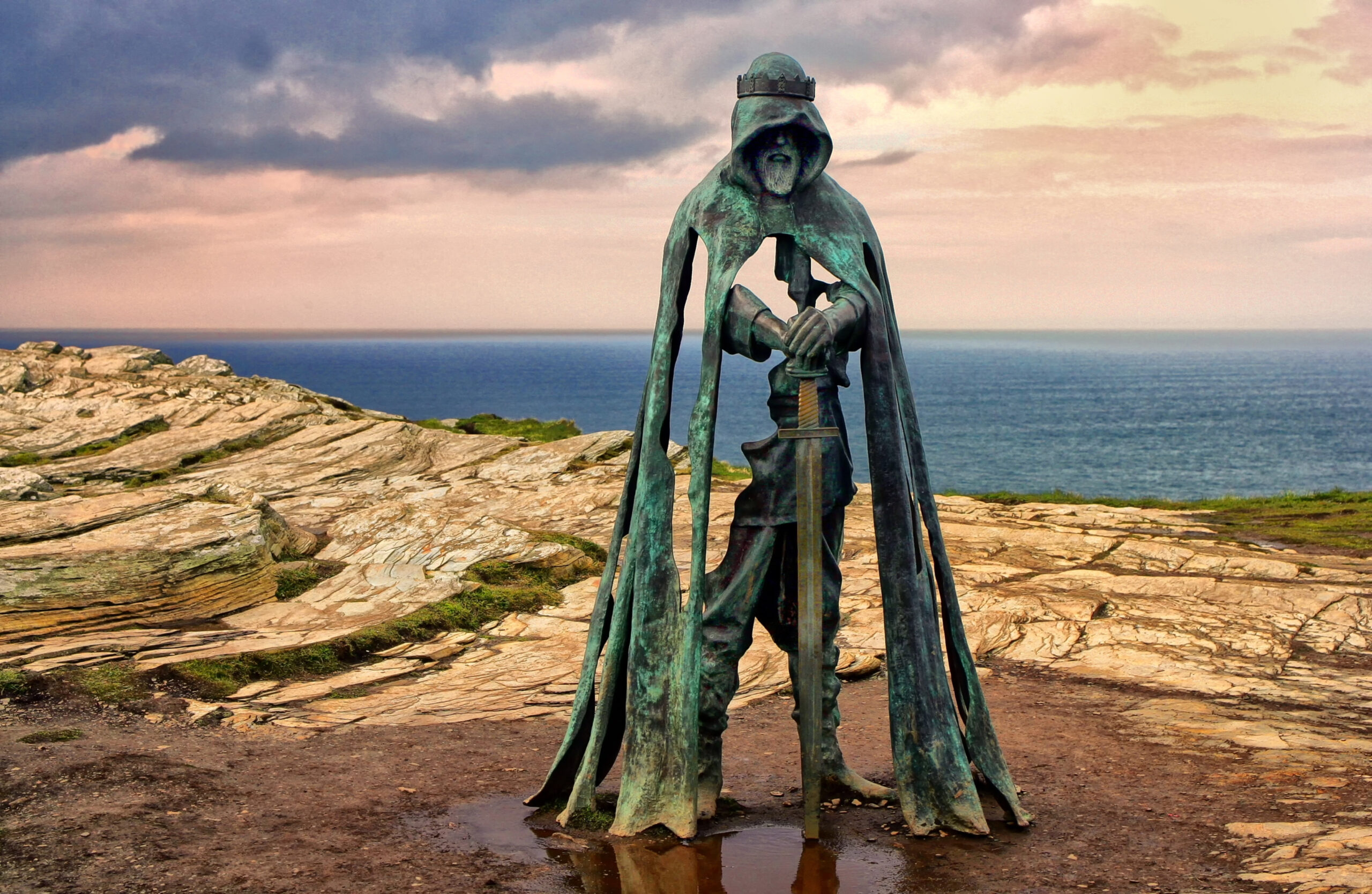Cornwall is the destination of longing in Great Britain: images of wildly romantic coastlines immediately appear in your mind’s eye, you immediately think you can hear the sea rushing against the beach and see the heather blowing in the wind with a spicy breeze over the rolling hills.
Idyllic cottages, cute fishing villages, romantic manor houses and weathered castle ruins come to mind. Cornwall delights its visitors with postcard motifs at every turn. You could almost be forgiven for thinking that this stretch of land in the southwest of England was created for the sole purpose of being captured in photographs. If you want to get away from it all and are looking for a landscape that will soothe your soul, then you’ve come to the right place!
Cornwall is one of the 39 historic counties of England and is located in the very southwest of the island. However, although it is part of England, in many ways it appears to be a country in its own right. Most travel guides refer to “Cornwall and South West England” and treat Cornwall as a separate part of the country. And there is still a special breed of people here who seem to be deeply rooted in the land.
Compared to the rest of England, Cornwall is also relatively sparsely populated: Just 500,000 people live in just under 3,500 square kilometers. That leaves plenty of space for wild, untouched nature and secrets.
Minack Theatre
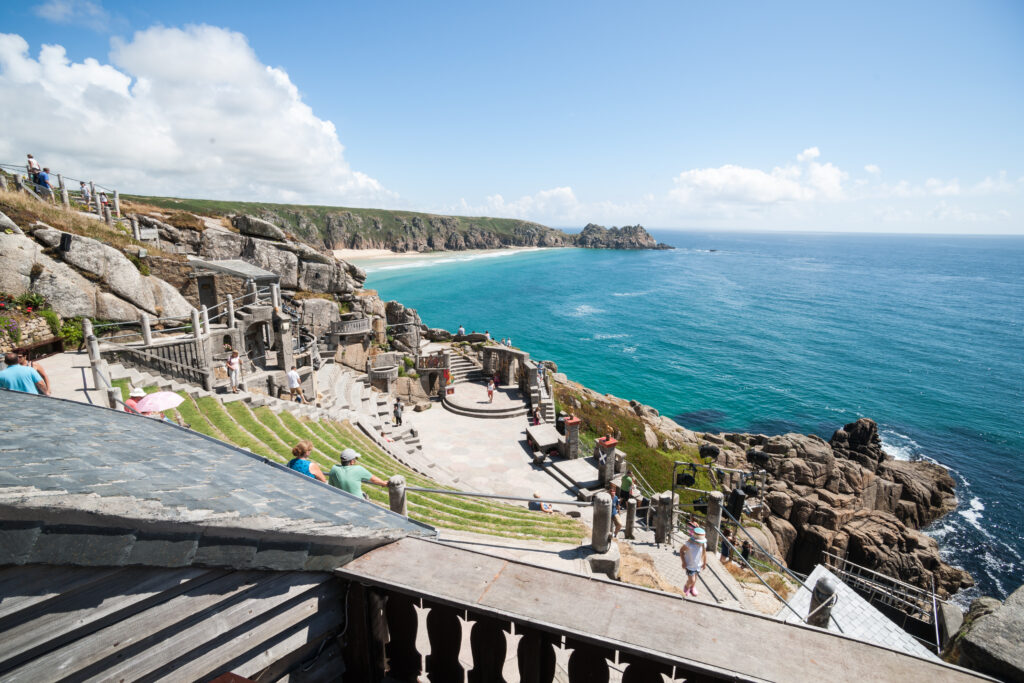
At a time when performances of plays were extremely rare in Cornwall, far away from the theatrical world of London, an open-air theater was created virtually on the rocks of the coast, which still has a name throughout the country today: the Minack Theatre.
In 1929, the then famous actress Rowena Cade performed Shakespeare’s “A Midsummer Night’s Dream” with a group of amateur actors in a meadow just a few kilometers from today’s Minack Theatre. It was a great success. Visitors came from near and far, on foot and in carriages, just to see a play, which was a rarity for them at the time.
The success encouraged the actors to continue the theater performances. However, she needed a more suitable location. She found one below her house, Minack House, in her garden, which led down to the cliffs of the coast.
For two years, with the help of her gardener Billy Rawlings, she worked on building the theater on the rocks. Rock slabs were moved and, piece by piece, seats were made from stone and concrete and inserted into the rocks. A truly Herculean task! In 1932, the Minack Theatre was finally opened. It was a real success! Against the backdrop of the sea, the actors now performed plays and brought a piece of art to Cornwall.
Eden Project
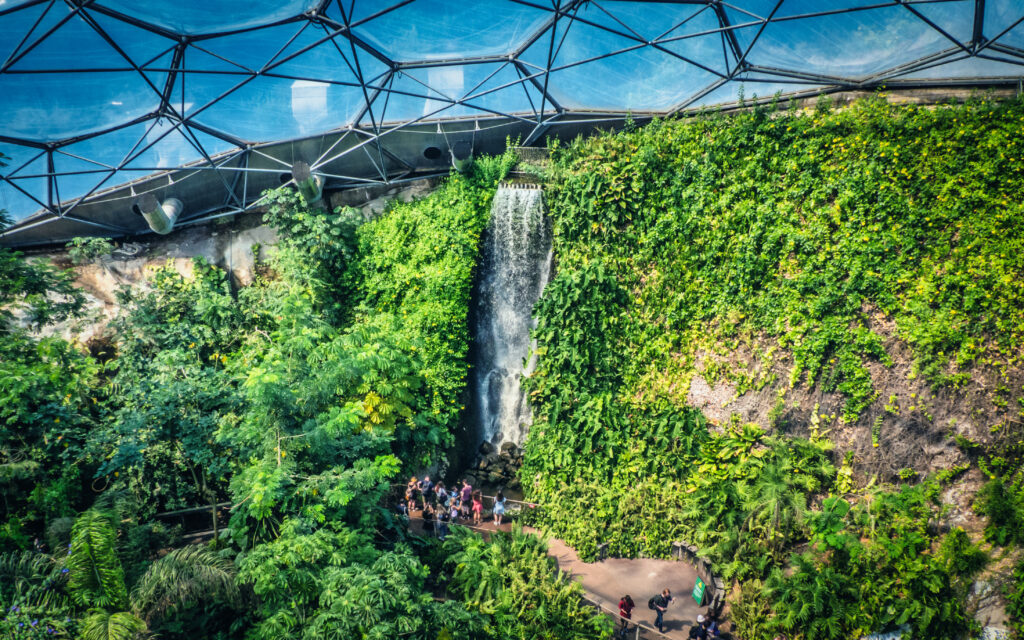
At the turn of the millennium, a gigantic project was launched in the middle of Cornwall: the Eden Project. It is much more than just a botanical garden, but a place for nature lovers, a place of inspiration and a symbol of sustainability.
The Eden Project has created several architecturally impressive greenhouses in which more than 1,000 species have found a home. And so it is no surprise that the Eden Project has become one of the main attractions and biggest sights in the whole of Cornwall. It’s a place not only to marvel at the diversity of plants around the world and see exotic plants that you would most likely never see otherwise.
It is also a place to learn how to live in harmony with nature, how to use nature for yourself and how to give something back to nature.
Three gigantic greenhouses were built on the uneven surface of the clay pit, which are shaped like hemispheres that look like bubbles.
Scaffolding with a length of over 360 km was erected for the construction of the greenhouses.The Eden Project then made it into the Guinness Book of Records.
The three greenhouses are the main attraction.They are called biomes and are divided into a Mediterranean greenhouse and a rainforest greenhouse.The whole thing is complemented by the so-called Core, where you can learn all about the plant world and environmentally friendly living.
Penzance
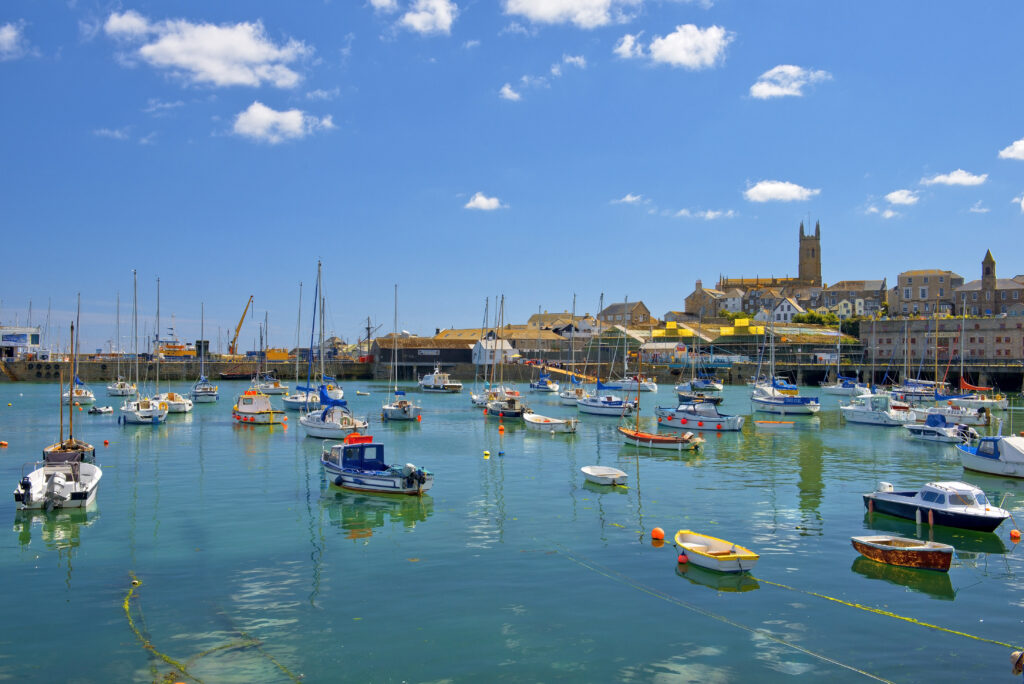
The friendly, bustling port of Penzance lies on the northern edge of Mounts Bay with Cornwall’s only promenade, which is long and enjoys magnificent sea views. The harbor is small but busy with fishing boats, sightseeing boats and the passenger ferry to the Isles of Scilly. Behind the quay are small streets and lanes with houses, stores, art galleries, restaurants and pubs – plenty to explore.
Chapel Street is a delight to wander along with its mix of pretty Georgian and Regency houses, including the magnificent Egypt House. Market Jew Street derives its name from the Cornish ‘Marghas Yow’, meaning Thursday market; the street has an elevated granite terrace and a domed market hall. At the end of the street is a statue of Sir Humphrey Davy, the inventor of the miners’ safety lamp.
The Morrab Gardens are located on the quayside and were planted with sub-tropical plants in Victorian times. Penlee House Gallery and Museum is home to many works of art by artists who resided in Newlyn in the 19th and 20th centuries. The Exchange is a contemporary art gallery that opened in 2007 in conjunction with the Newlyn School of Art; the building is the town’s old exchange office.
Newlyn is a fishing village south of Penzance. There is a thriving early morning fish market and the Newlyn Art Gallery.
St. Ives
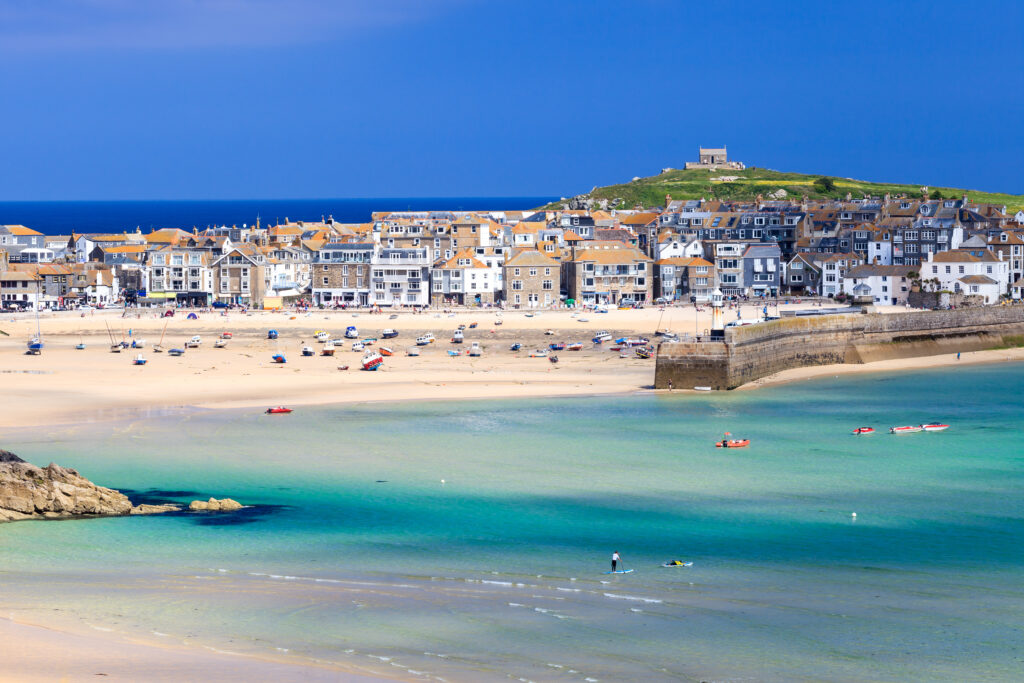
The sea shimmers turquoise blue in front of inviting white and fine sandy beaches, flowers and palm trees give the backdrop an almost tropical appearance. Welcome to St. Ives, the beautiful artists’ town in Cornwall, which conjures up images of a relaxing paradise for all guests.
In the north of the Penzance Peninsula, a mild climate and magnificent scenery have created a popular vacation resort – which has inspired the work of numerous artists and well-known writers. Discover the colorful paradise of St. Ives on the Cornish coast and look forward to insights into the landscape and art in the south of England.
St. Ives is not considered one of the highlights of Cornwall for nothing and is a particularly interesting destination for art connoisseurs, artists and nature lovers.
All the beaches around St. Ives have won several awards for the quality of the sand, the wonderful location and the views. The two large beaches Porthmeor Beach and Porthminster Beach are located directly near St. Ives, as well as the long St. Ives Bay.
A camera should therefore not be missing due to the very special view, as St. Ives is a truly beautiful picture motif in wild and romantic Cornwall. We also recommend a visit to the narrow alleyways and the many stores in the town, especially the galleries, small art stores and studios.
St. Michael’s Mount
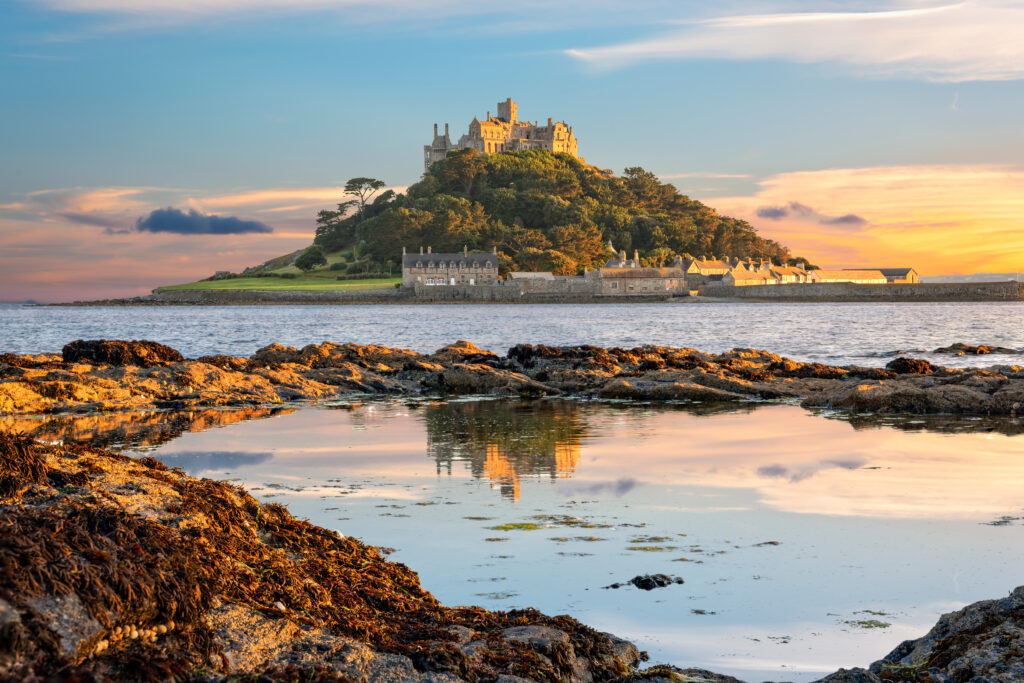
Often shrouded in mist, surrounded by a glistening sandy beach at low tide and rising proudly out of the sea on a clear day, St. Michael’s Mount has bravely defied wind and weather for thousands of years. Finds indicate that the small tidal island was already inhabited in the Bronze Age.
Today, St. Michael’s Mount is considered one of Cornwall’s landmarks. Like the famous Mont Saint-Michel, its French counterpart in Normandy, the island with its castle and abbey has long been a popular pilgrimage destination for Scots and Irish coming from the north on their way to Santiago de Compostela. Due to its similarity, St. Michael’s Mount is therefore often confused with the much better-known Mont Saint-Michel.
Benedictine monks from the French Mont Saint Michel built a monastery on the island mountain off Cornwall in the 11th century, following the example of their homeland. Later, the religiously used island became a base for fortifying the south coast and a castle was built. The estate is now privately owned but can be visited.
The castle is the centerpiece of St. Michael’s Mount, and the upper terrace offers a magnificent view over the island’s mountain, the sea and the coast. In summer, visitors can also enter the castle gardens on selected days. A highlight is the subtropical garden with plants from faraway countries such as Mexico and South Africa.
Porthcurno
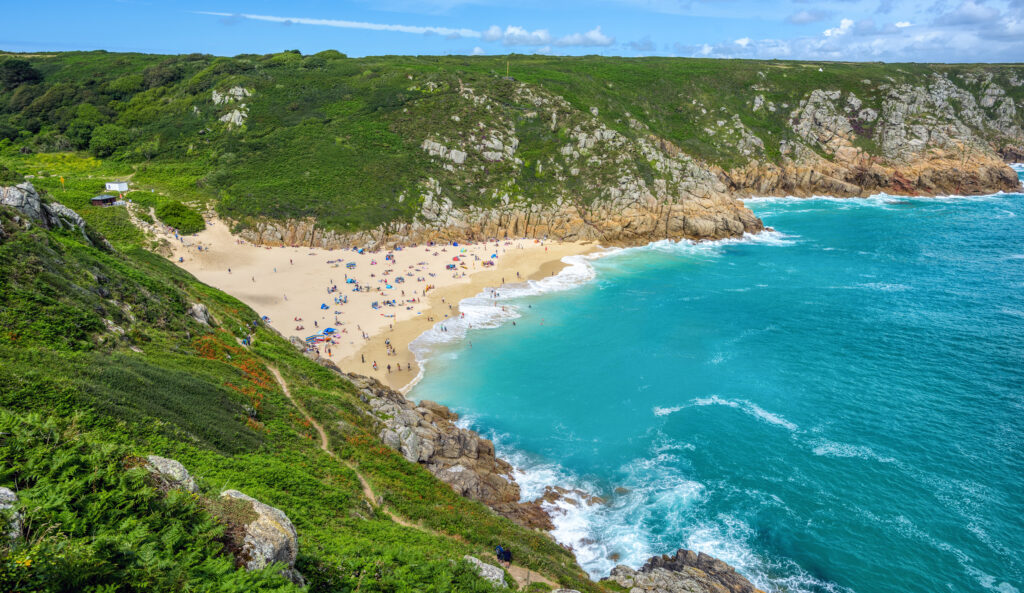
Porthcurno beach is located on the south coast of Cornwall next to the towns of Land’s End and Penzance. The small settlement on the southwest coast of England was established in the late 19th century and impresses with its turquoise blue sea, high cliffs and hidden coves.
Porthcurno Beach is not only a white, soft and clean sandy beach, but also the perfect destination for a family vacation. At the upper end of the beach there is a stream that is ideal for paddling – even with children. In the right conditions, Porthcurno is also extremely popular with surfers.
If you want to observe animals in the wild, Porthcurno Beach is the place to be. The area is one of the most exciting coastlines in the UK for wildlife spotting. Dolphins are regularly spotted here, sometimes they even frolic close to the beach.
Porpoises and even the rare minke whale can also be spotted here. Basking sharks can be seen in the waters of Cornwall in spring and summer. They can also be seen from the beach. Some of the best places for bird watching are the headlands around Porthcurno.
The nearby gardens of Penberth and Chygurno in Lamorna are also worth a visit. The Minack open-air theater, which has been operating since 1932, and the Porthcurno Telegraph Museum are also close to the beach. Around 30 minutes’ walk away, you can marvel at the Logan Rock, a granite rock weighing around 80 tons.
The Roseland Peninsula
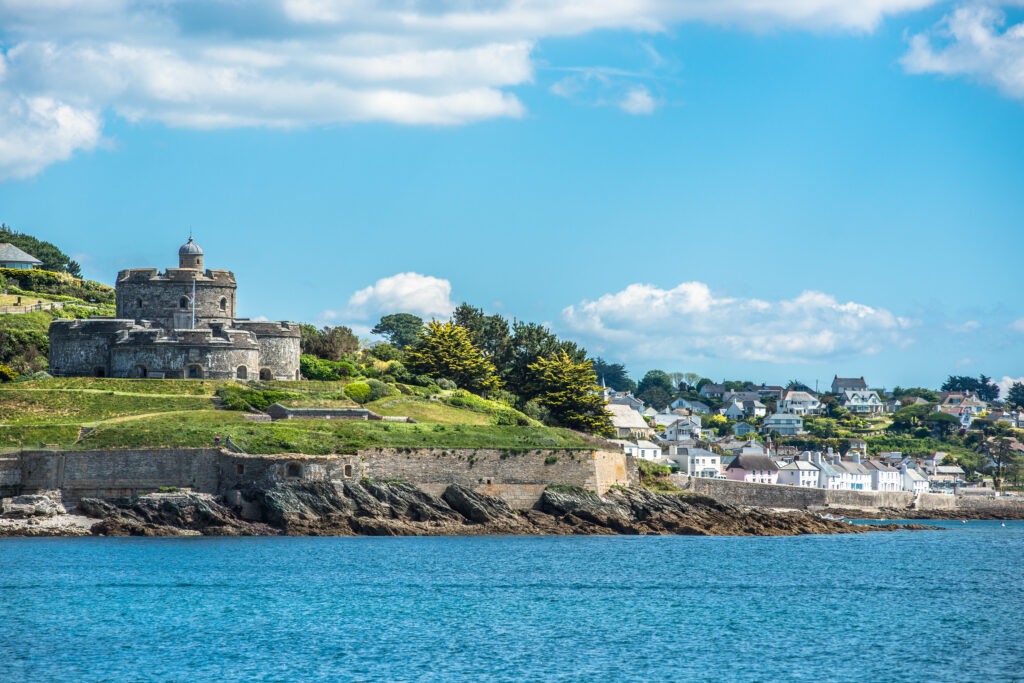
Few places in Cornwall can compare with the Roseland – one of the most picturesque and unspoilt parts of the British Isles. Lovely beaches and cliffs, delightful rivers and countryside, pretty villages and hamlets all make the Roseland the perfect holiday setting.
Here you can walk the cliffs or riverbanks, swim off the beaches, browse the shops, sail, windsurf, waterski, dive. snorkel, fish and birdwatch. During the warmer months there are carnivals and fetes, regattas and gig racing, not to mention the heavy horse show and all the wonderful gardens open to the public.
Variety being the spice of life, the Roseland offers a wide selection of places to stay to refresh the inner man. Traditional hotels, farm-house bed and breakfast, lovely guest houses, quality cottages and caravans or well equipped camp sites provide your style of accommodation to the standards you expect. Flower covered pubs, riverside barbeques, cream tea cottages and restaurants of high repute add a little more magic to your holiday.
Padstow
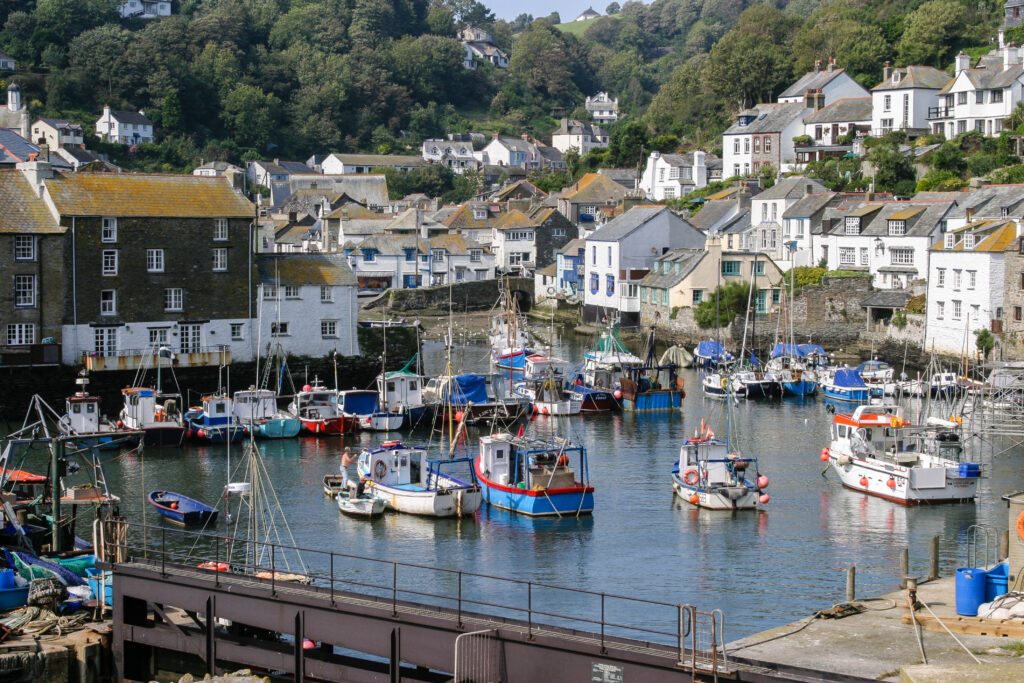
Padstow is a harbor town in the north of Cornwall and also the administrative seat of the municipality of the same name. Due to its location at the mouth of the Camel, Padstow is heavily dependent on the tides. At low tide, the sandbanks are visible and ships cannot enter the small harbor even in the shipping channel.
A shoal at the mouth of the Camel into the Atlantic has already been the undoing of many ships. The climate in Padstow, like everywhere else in Cornwall, is a temperate Mediterranean climate, which makes for mild winters. However, this climate also means that it is quite damp all year round. Padstow was first mentioned in history around 2000 BC, when the Bell Beaker culture, an end-Neolithic culture, spread to Cornwall.
Burial chambers have been found near Trevone, which were built by followers of this culture. For tourists coming to Padstow, there are a number of attractions that are well worth a visit. First and foremost is St. Petroc’s Church, which is dedicated to St. Petroc, who lived here in the 6th century.
Petroc is revered as a saint by the locals today, but he came to Padstow as a simple missionary and founded a monastery there in order to proselytize the southwest to Christianity.
The Lizard Peninsula
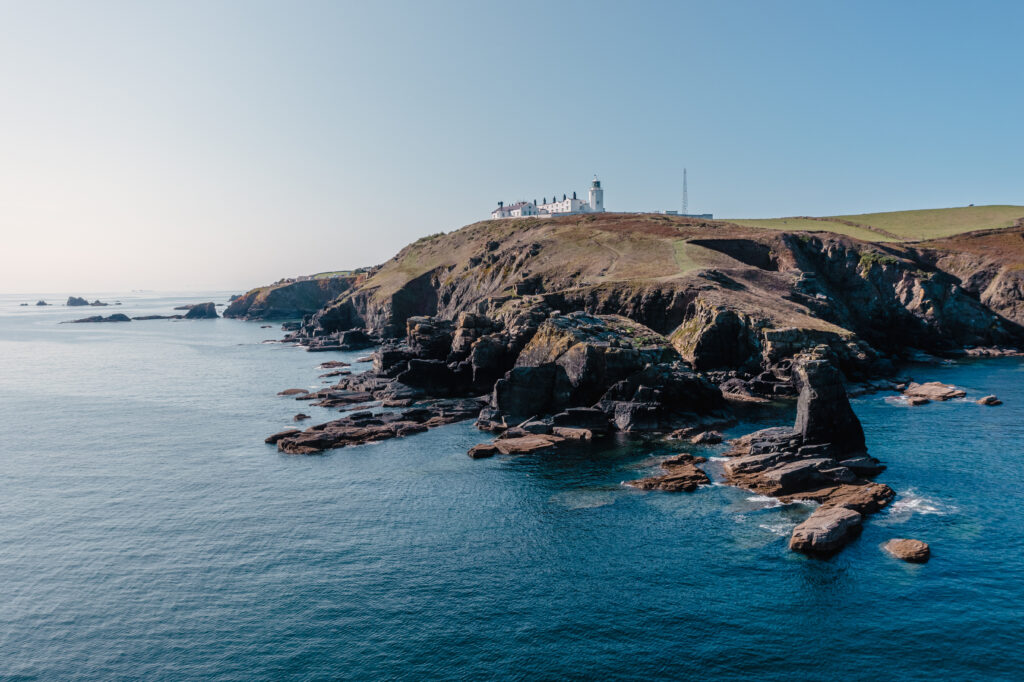
The Lizard Peninsula is a large area of lowlands surrounded by sea cliffs. The peninsula ends at Lizard Point, the southernmost tip of Britain. Rare plants grow on the extensive heathland and coastal paths. Visitors are asked not to pick wild flowers and plants.
North of Lizard Point is the River Helford, with gentler scenery of wooded coves and peaceful villages, leading on to the magnificent natural harbor of Falmouth. At the western gateway to the Lizard is the market town of Helston, famous for its Flora Day Festival.
The Lizard Peninsula is a well-known, much-loved and protected area which has been granted various special statuses and is part owned and cared for by Natural England, the National Trust and the Cornwall Wildlife Trust. Not only is it a National Landscape, but there are also eight Sites of Special Scientific Interest for the protection of wildlife and geology.
The Manacles, notorious for its shipwrecks, is one of the richest areas of marine biodiversity in Cornwall and has been designated a Marine Protected Area. Natural England recognizes the Lizard Peninsula as a National Character Area, citing a strong sense of place and tranquility.
Helford and the Helford River
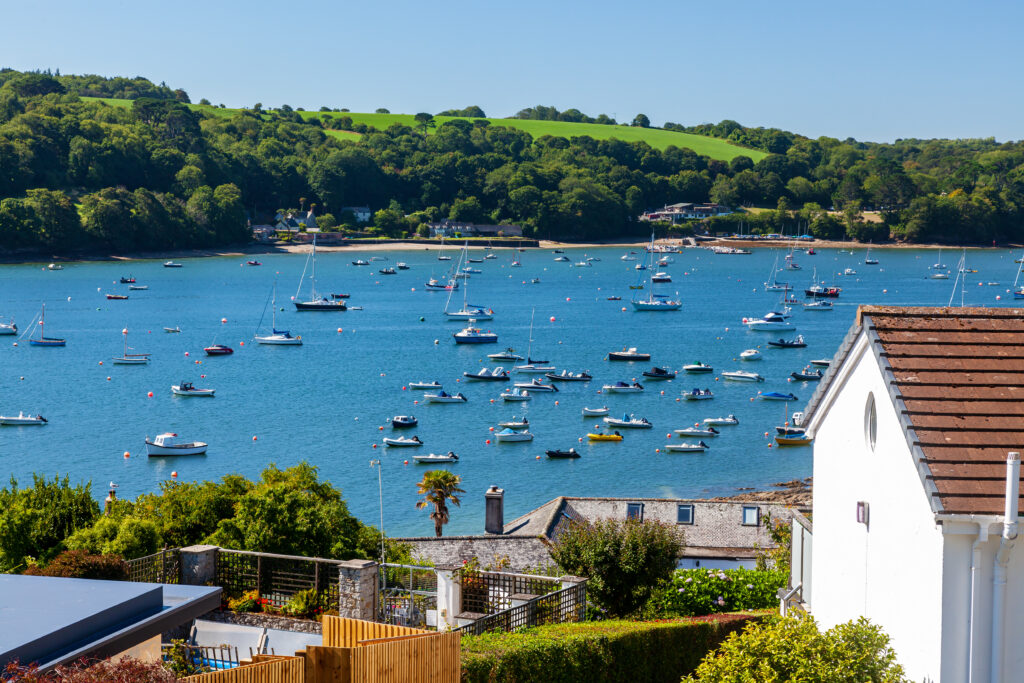
Helford and the Helford River north of the Lizard Peninsula is a romantic and tranquil place. The muddy, tree-lined creeks of the river inspired du Maurier’s romantic story Frenchmans Creek. Up on the Helford River is the village of Gweek, once a busy port but now a sleepy riverside village.
Here you’ll find the National Seal Sanctuary, set within 40 acres of glorious Cornish countryside and a wonderful day out. In season there is a passenger ferry that crosses the river at Helford to Helford Passage, where you will find Trebah and Glendurgan Gardens.
Kynance Cove
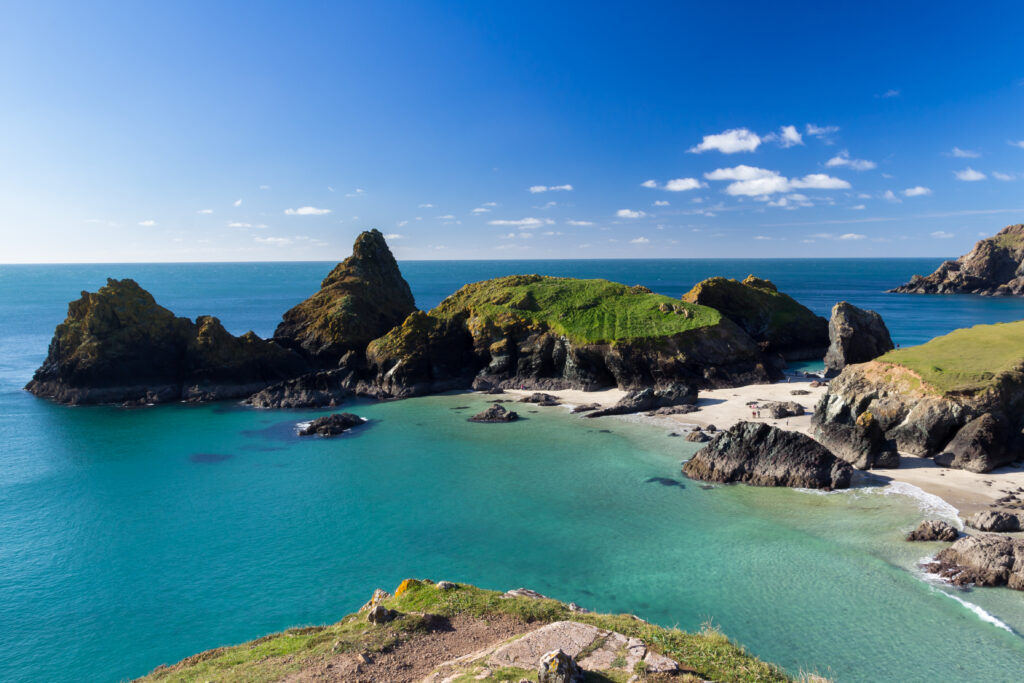
The scenic Lizard Peninsula stretches along the southernmost tip of England. Green hills, steep cliffs, fine beaches and breathtaking views of shimmering emerald green water enchant guests as they take in the scenery.
But none of the beaches can match the beauty of Kynance Cove, clearly one of the most extraordinary bays in the region. Explore the magnificent Kynance Cove beach and enjoy the special landscape, which has a magic all of its own and is one of the most important sights in Cornwall.
Land’s End

There are places that are hard to miss on a Cornwall vacation – even if you know that the place itself is nothing out of the ordinary. Land’s End is one such place. You don’t come to Land’s End because the cliffs here are particularly dramatic and breathtaking, or because the green hilly landscape in the hinterland is particularly idyllic.
Nor do you come here because you expect the best entertainment from the visitor center. Land’s End is a symbolic place: the western end of the British mainland.
Even the name resonates with something that sounds like wanderlust. It is a turning point, a waymarker, a starting point or an end point. Anyone traveling along the south coast of England has Land’s End in their sights from the moment they get off the ferry in Dover and are heading towards it.
After Land’s End, you can also simply take a day trip to the south-western tip. By the way, you can also visit Lizard Point, the actual southernmost point of England, around 40 kilometers southeast of Land’s End. If you want to avoid the hustle and bustle of Land’s End, you can either get there very early or very late.
Or you can stay at the Land’s End Hotel and have the otherwise turbulent tourist hotspot all to yourself in the late evening.
Port Isaac
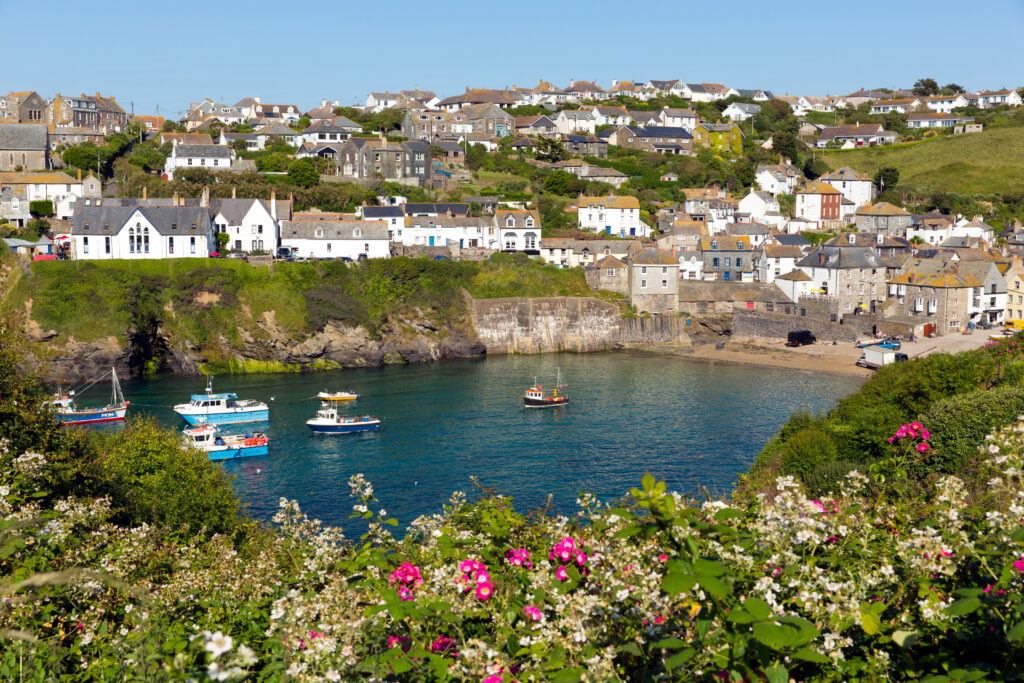
Port Isaac is located on the north coast of Cornwall and offers an idyllic setting with narrow streets, traditional fishermen’s houses and a picturesque harbor. The natural beauty of the coastline and the surrounding countryside make it a popular tourist destination.
Port Isaac is internationally known as the filming location for the popular British television series “Doc Martin”. The village serves as the backdrop for the fictional town of Portwenn and many of the distinctive buildings can be recognized in the series.
The harbor is an important part of the village community. Watch the fishing boats come and go and sample fresh seafood in one of the local restaurants.
Port Isaac is an ideal starting point for walks along the South West Coast Path, one of England’s most spectacular coastal walks. Enjoy breathtaking views of the sea and cliffs during your walk.
The Platt is the central square in Port Isaac and a popular meeting place for locals and visitors alike. Here you will find a selection of stores, cafés and restaurants where you can enjoy local produce and cuisine.
Watergate Bay
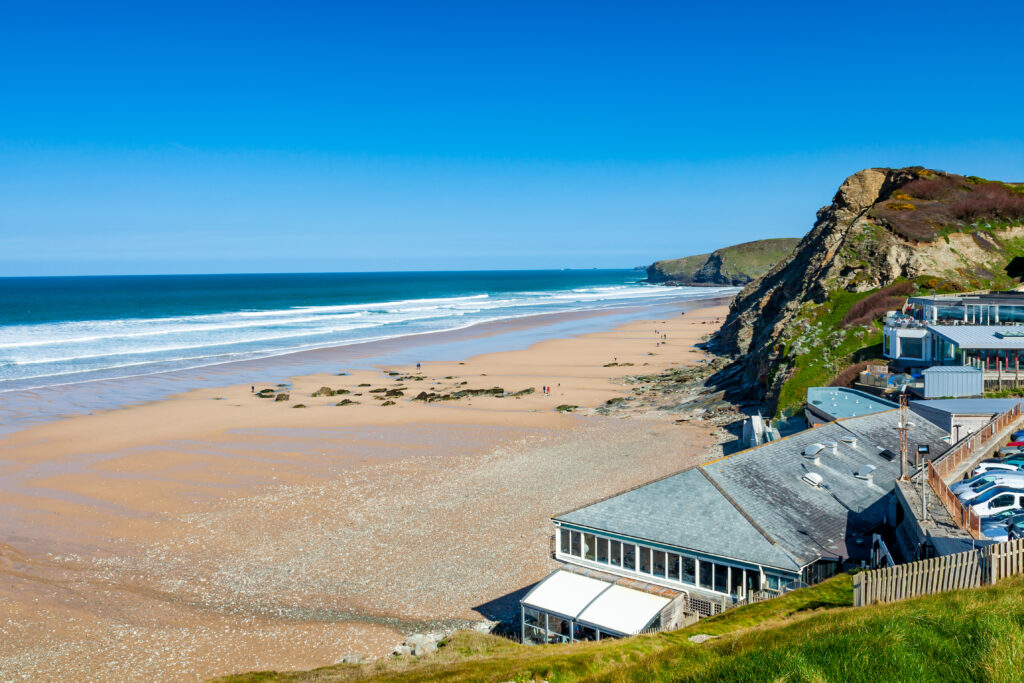
At low tide, the beach at Watergate Bay in Cornwall is three kilometers wide. Seagulls circle between the high rocks that border Watergate Bay on the north coast of Cornwall.
It is just under five kilometers to Newquay, so the Atlantic waves break evenly over a long distance and are particularly suitable for beginners. Surfers of all ages meet here, from beginners to advanced surfers.
Surfers with decades of experience get on their boards here and enjoy the weather as well as the family character of the beach. It is one of several beaches in Cornwall that invite you to surf and are monitored by the RNLI (Royal Nation Lifeboat Insitution).
Watergate Bay, however, is stretched out and invites surfers, families and dogs to enjoy life on the beach – at least when the sun is playing along with the waves, which is not always the case in Cornwall. In front of the beach, not far from the famous Fistral Beach in Newquay, there are not only expensive SUVs, but also old converted camper vans that may have been around in the days of the Beach Boys.
Those who are not afraid of the cold water outside of summer will find good conditions in Watergate Bay for daring to ride the waves and practise their board and water skills.
Truro
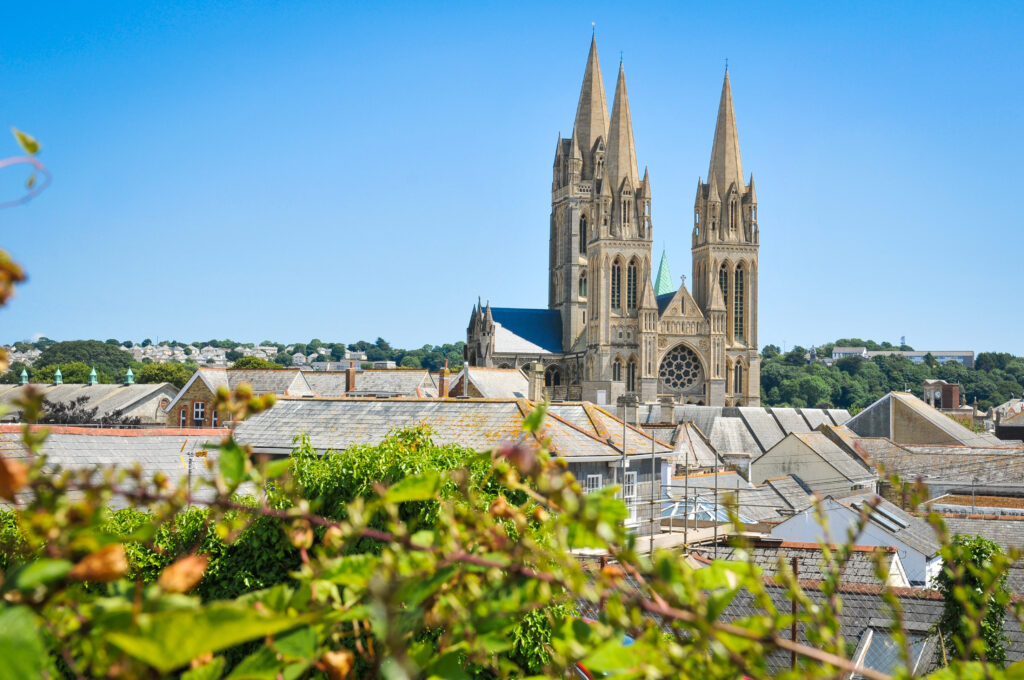
The capital of Cornwall is Truro, which lies on the river of the same name, which in turn flows into the River Fal. Copper and tin, which was mined in the Cornish mines, was once shipped far and wide from the port in Truro.
In the 17th century, however, the port began to silt up and the city’s prosperity declined for a while, until the railroads reached Truro in 1859. Another important highlight of Truro’s current status as the capital of Cornwall was the granting of city rights in 1877.
The sights in Truro are easy to explore on foot.
The small streets of Truro criss-cross and you can stroll along the old typical Cornish houses and browse through the stores. One of the highlights of a stroll through Truro is of course Truro Cathedral, which was completed in 1910 as the last and therefore youngest cathedral in Cornwall and was built in the neo-Gothic style.
Today, Charlotte’s Tea & Coffee House can be found in another historic building in Truro, the former Coinage Hall on Boscawen Street.
A stroll through the city will inevitably take you to Lemon Quay, situated on the River Truro.With its warehouses, this area was once the center of Truro’s trade.In 1928, Lemon Quay was filled in to create the city’s first parking lot. Today it is a public square with benches and street musicians.
Polperro
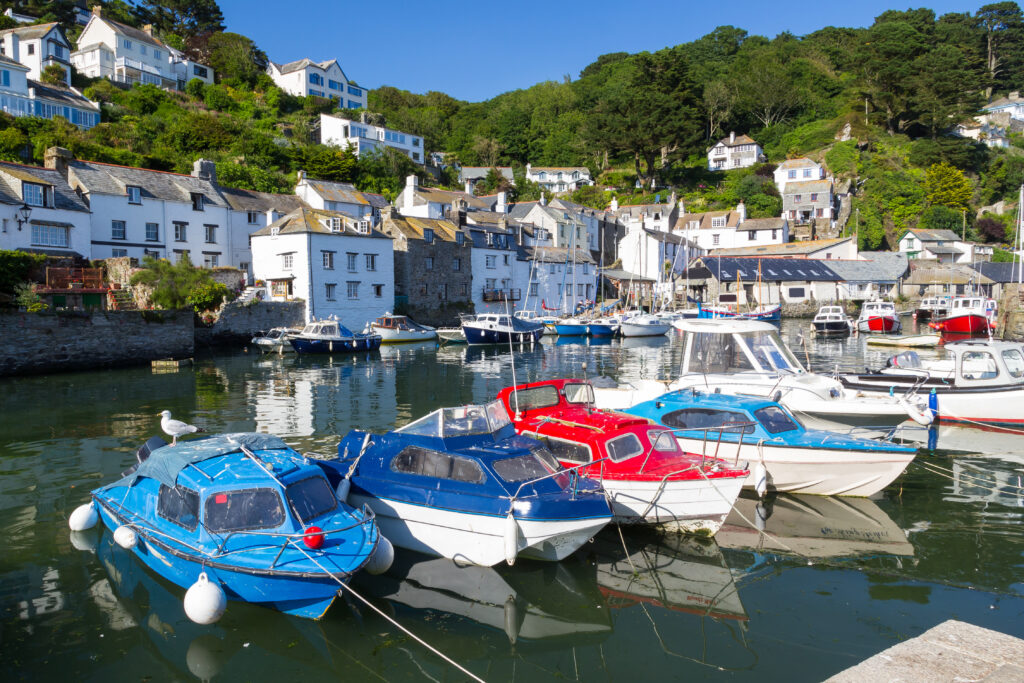
Polperro is located at the end of a deep, wooded valley; it is a charming fishing village with narrow streets and quaint cottages and houses around the harbor. Polperro is mostly car-free and is best explored on foot. There is a large parking lot on the edge of the village. It is one of the prettiest and most popular villages in Cornwall and can get quite busy in the summer.
There is a small sandy beach in Polperro, right by the harbor wall. Here you will find a small cave named after Willy Wilcox, one of the notorious smugglers who once lived in Polperro.
It is ideally situated for walking along the South West Coast Path; you will experience spectacular views as you walk west towards Lantivet Bay or east towards Talland Bay and then on to Looe through one of Cornwall’s Areas of Outstanding Natural Beauty.
Tintagel
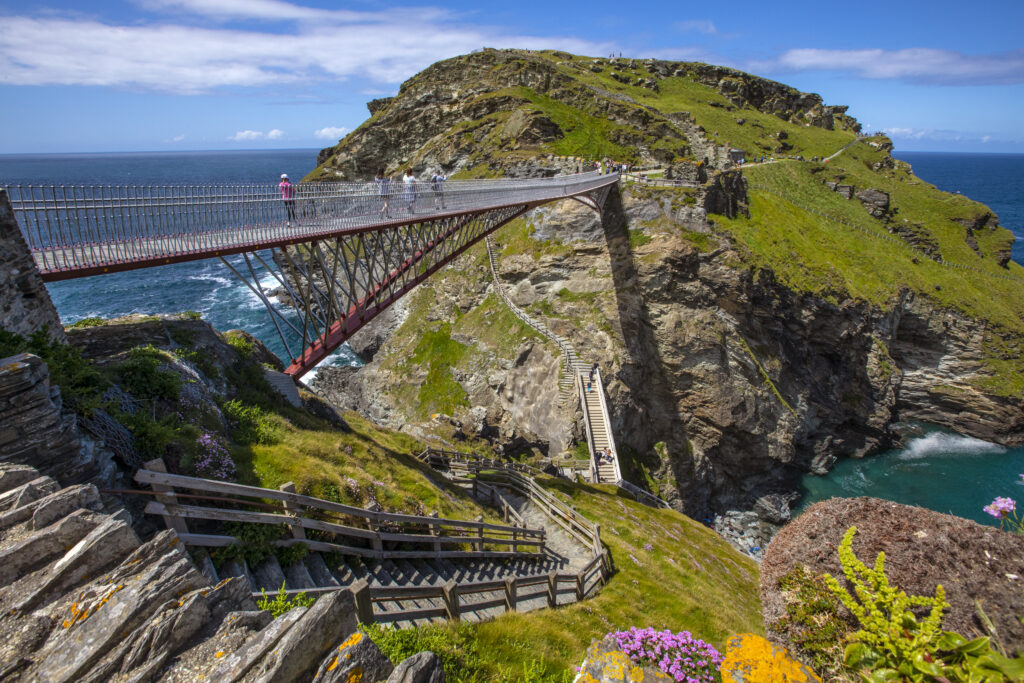
Tintagel on the North Cornwall coast is famous for the ruins of Tintagel Castle on the awe-inspiring headland known as ‘The Island’. The castle dates back to the 12th century and is steeped in history, romantic tales and the legends of King Arthur. The dramatic and spectacular landscape adds to the mystical atmosphere.
The village of Tintagel is home to the Old Post Office, which is owned by the National Trust and is a rare example of a 14th century medieval longhouse. This eccentric building has been used for numerous purposes over the years, including a post office in Victorian times.
Tintagel beach below the cliffs is one of the town’s best kept secrets, perfect for paddling and exploring in the rock pools. At low tide you can explore the atmospheric Merlins Cave.
St. Austell
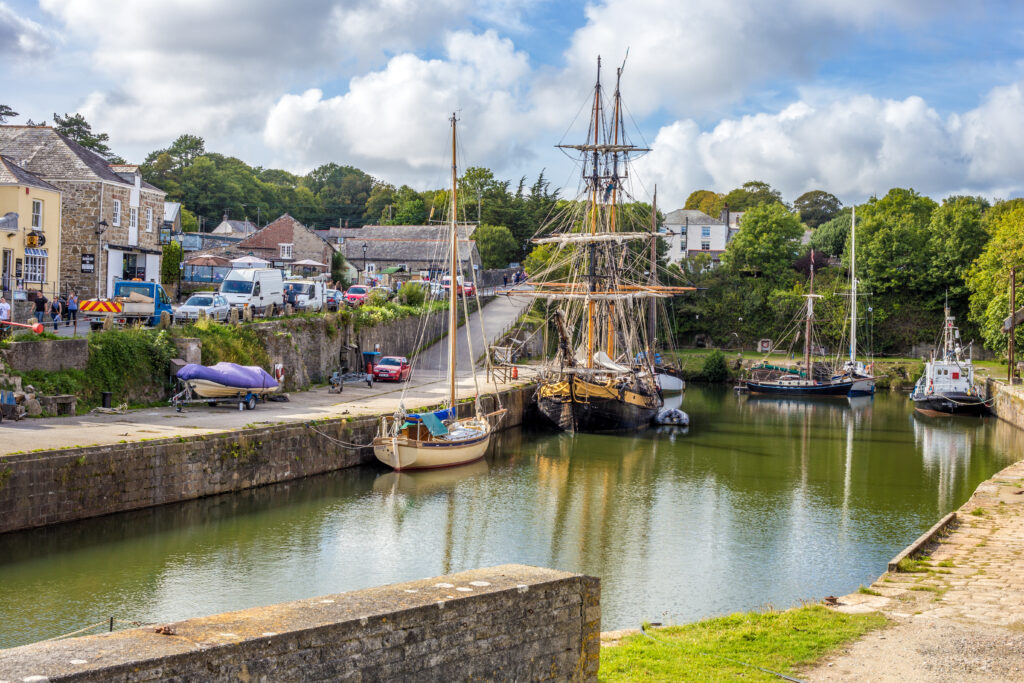
St Austell is an old market town that has grown because of the porcelain industry. The landscape around the town is shaped by the output of the clay pits, large white conical hills called the ‘Cornish Alps’.
The Lost Gardens of Heligan are among the finest gardens in Cornwall. The estate was once home to the Tremayne family for over 400 years. However, in the early 20th century the gardens were neglected and overgrown, falling into oblivion until 1990 when they were rediscovered and restored to their former glory.
Charlestown is the delightful old port of St Austell; it is a pristine Georgian port that is still in use and has been the setting for numerous film and television productions, including Poldark.
One of the old buildings used to make china houses the Shipwreck, Salvage and Museum Center, with a variety of historical items and animated scenes depicting life in Charlestown through the ages. It is a fascinating place.
Beaches near St Austell include Pentewan, a large sandy beach ideal for all water sports, Porthpean, a safe, sheltered sandy beach popular with families and Gorran Haven, which lies to the south of Mevagissey; a large sandy beach sheltered by the 114m high Dodman Point, the highest headland in South Cornwall with an Iron Age rampart and spectacular panoramic views.
Lanhydrock
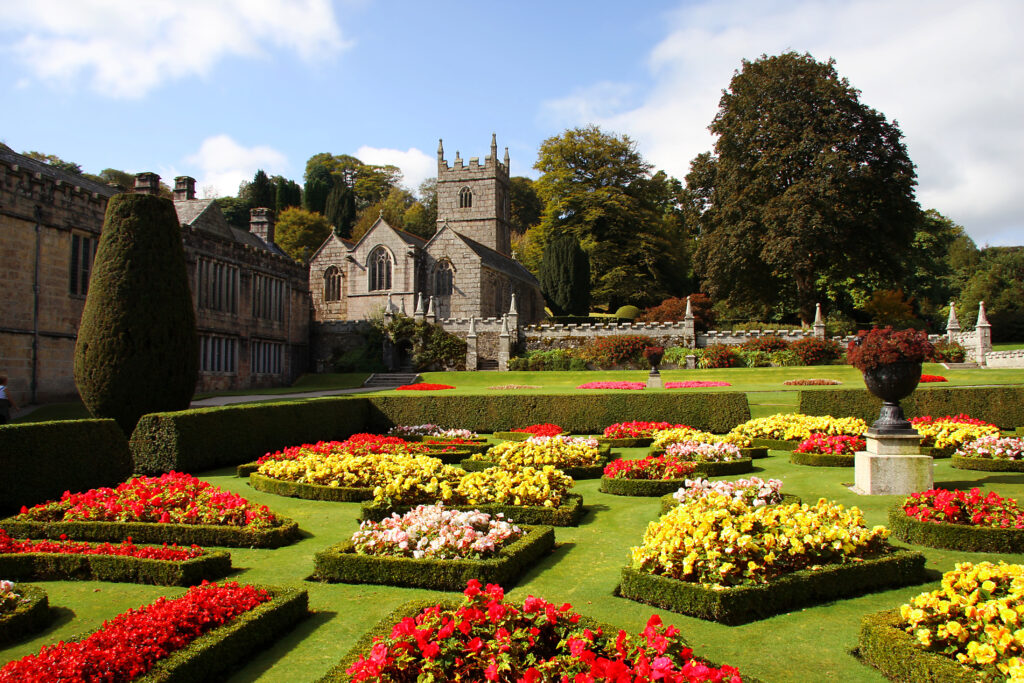
Lanhydrock House and its gardens lie at the foot of a hill and are surrounded by woodland. A long driveway leads through the park to the house, a park which contains some extraordinary trees, many of which date back to 1634.
Lanhydrock is the perfect country house with the ambience of an affluent but unpretentious family home.
The kitchen, nursery and servants’ quarters reveal an insight into the lives of the servants, while the luxurious, elegant dining rooms and spacious bedrooms show the life of the lordship. The public tour of Lanhydrock is one of the longest offered by the National Trust.
The house is undoubtedly one of the most impressive and popular historic houses in Cornwall. Built of local gray slate and granite around a courtyard, the building dates back to the 17th century, but most of the current building is the result of a rebuild after a fire in 1881.
Bodmin
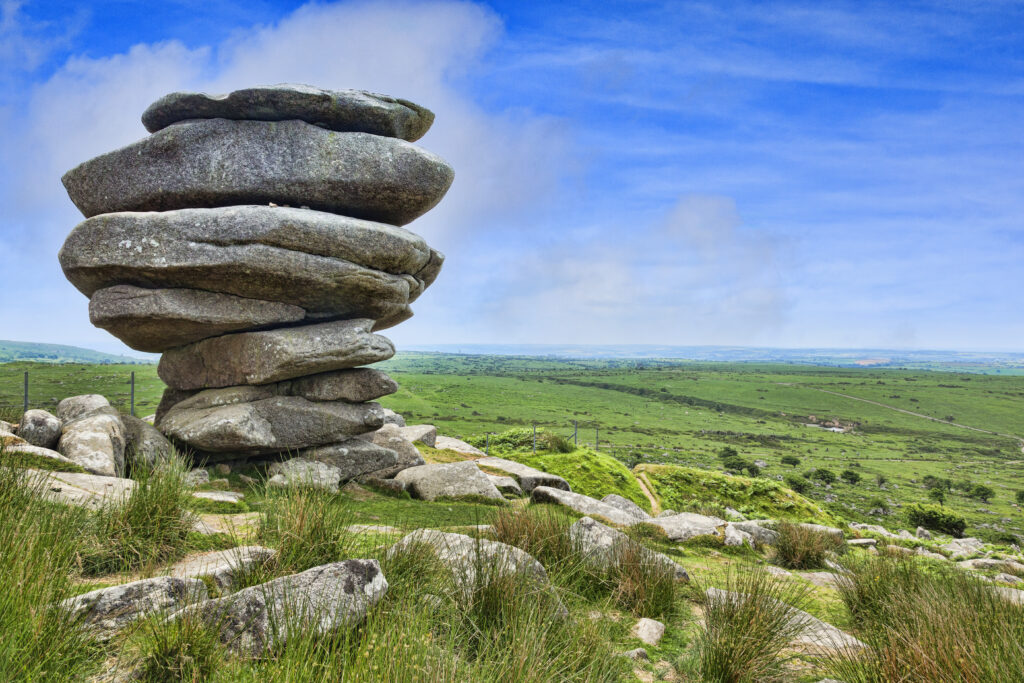
The small town of Bodmin was once the capital of Cornwall until it lost this status to Truro. It is one of the oldest towns in Cornwall and the only town in Cornwall mentioned in the Doomsday books. St. Petroc founded a monastery here and the 15th century church named after him is the largest church in Cornwall next to Truro Cathedral.
Bodmin Prison was built in 1779 during the reign of King George III using 20,000 tons of granite from Bodmin’s ‘Cuckoo Quarry’. Today it is a family attraction with fascinating exhibits that tell the story of this dark, mysterious place.
Bodmin Moor is Cornwall’s largest area of raised bog and is bisected by the A30. The eastern side is less wild and rugged than the rocky ridges of ‘Brown Willy’ and ‘Rough Tor’ to the west. The granite from Cheesewring Quarry at Minions village was used to build Devonport Dockyard, Birkenhead Docks and parts of Copenhagen Harbour.
It was also used to build the Thames Embankments, Westminsters and Tower Bridges. Today you can visit the recently restored Housemans Engine House with an exhibition on the history and nature of the area.
Calstock-Viadukt
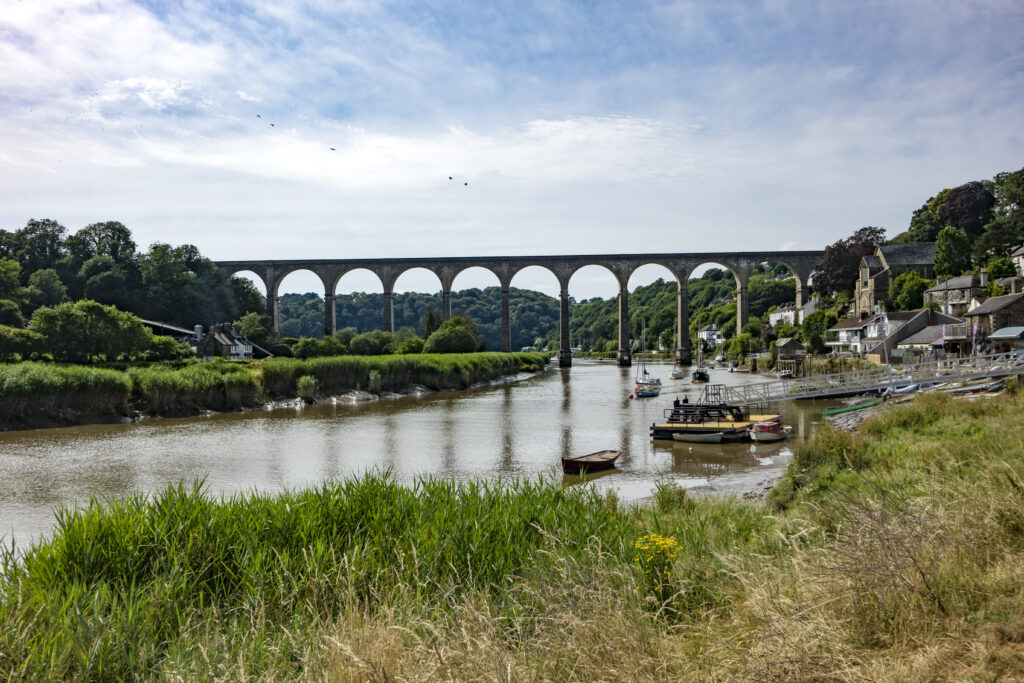
In the east of Cornwall, just before the border with the county of Devon, the River Tamar winds its way through the Cornish landscape in narrow bends and sometimes deep cuts. It flows into the English Channel at Plymouth and about 14 miles before is the village of Calstock.
Situated on the slope of the land that falls steeply down to the river, Calstock has two highlights: The nearby manor house and garden “Cotehele” and its viaduct for the railroad.
Built between 1904 and 1907 from solid reinforced concrete blocks, the very elegant structure of 12 arches with a length of more than 300 meters spans the River Tamar at a height of up to 37 meters.
On the northern side, the Calstock railroad station on the regional line from Plymouth to Gunnislake, which can only be reached via steep paths, is directly adjacent to the viaduct and exudes a certain “jungle atmosphere”.
Mousehole
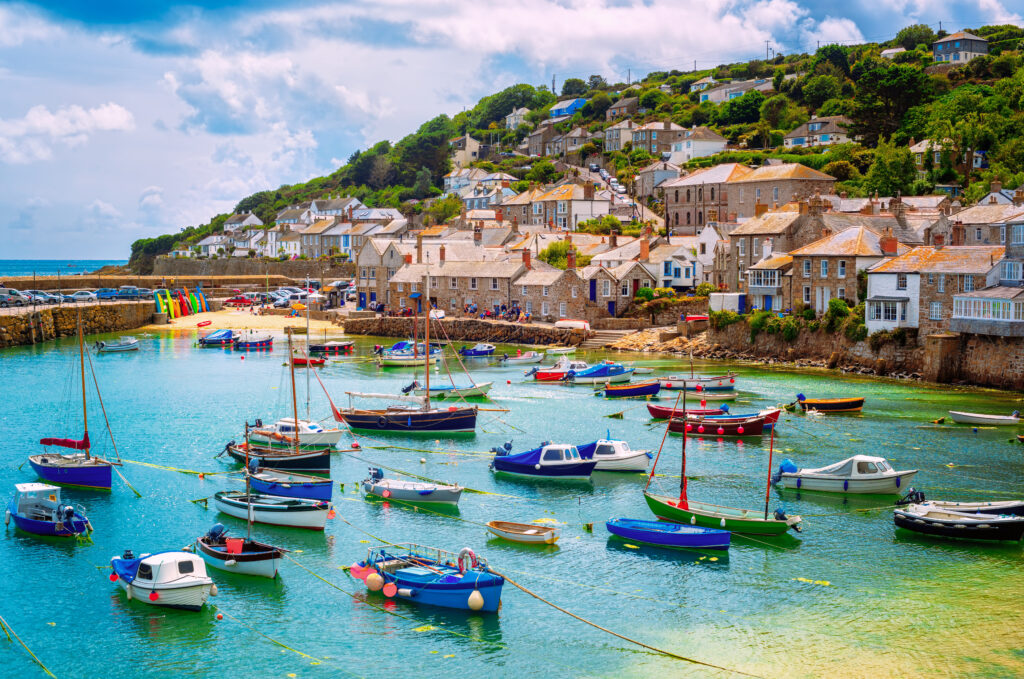
Mousehole was once primarily a small fishing village known for its sardine catches. In 1595, the village was almost completely destroyed by the Spanish. At the beginning of the 20th century, the shoals of sardines that were so important for fishing in the village disappeared and the village now lives mainly from tourism.
Fishing is still carried out on a small scale, which is one reason why the boats are moored in the harbor, on the ground at low tide and rocking picturesquely in the water at high tide.
The harbor of Mousehole, which is protected by the two quay walls, is additionally reinforced in winter by large lockable wooden beams, which then better protect the small town from the truly violent winter storms and the waves that then whip up.
In summer, on the other hand, the climate in the area is completely different, namely wonderfully warm and ideal for plants and flowers. They grow everywhere in the gardens and there are countless pots outside the houses or hanging baskets in front of the door. They add a picturesque splash of color to the cute granite houses.
Visitors can stroll along the small alleyways and winding streets and truly enjoy the tranquillity of the village. There are a few small stores, a small gallery here and there or a craft store and you can stop off at a small café, restaurant or pub along the way. However, the best place to do this is the area around the harbor.
Newquay
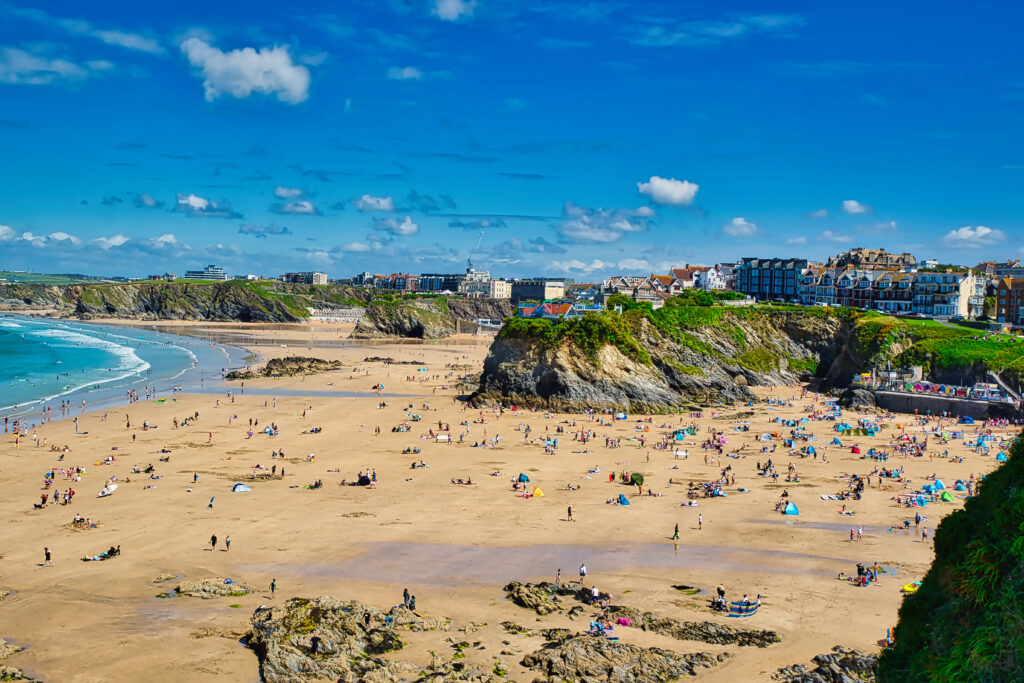
Newquay is a lively beach and surfing resort on the north coast of Cornwall. The bustling town has plenty of hotels, bed & breakfasts, stores, pubs and nightclubs, yet there are quiet corners in flower-filled parks and gardens.
Surfing championships are held every year at Fistral Beach, Holywell Bay and Perran Beach. At Watergate Bay there are also other water sports championships, polo on the beach and the annual Boardmasters, a music and surfing festival held in August. Towan Beach, Tolcarne and Lusty Glaze are more sheltered from the wind and therefore suitable for families.
Blue Reef Aquarium is located on Towan Beach in the center of Newquay and invites visitors on a spectacular underwater safari through the world’s oceans, from the Cornish and British coasts to tropical reefs on the other side of the world. It has an array of wonderful sea creatures, from tiny seahorses to the largest octopus species on earth.
Newquay Zoo is just a short walk from the town center, set within 13 acres of tropical gardens, it is home to more than 130 different animal species. It is one of the leading organizations dedicated to saving animals from extinction.
Fistral Beach is Newquay’s iconic beach, quite simply one of the most consistent and best surfing beaches in the UK and Europe. This beautiful beach is west facing, long and sandy and backed by rocks and cliffs. Fistral is the perfect family beach offering simple pleasures of sea and surf combined with first class beach and seafront facilities including surf equipment hire, lessons and boutiques, showers, toilets, car parking, restaurants and cafes.
Boscastle
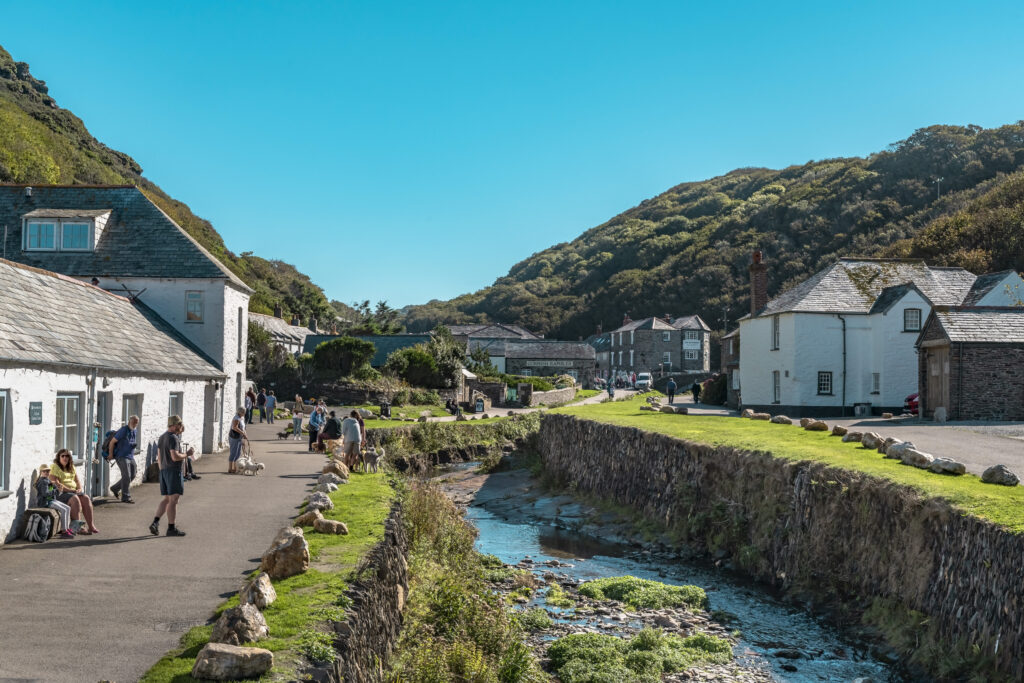
The picturesque harbor of Boscastle is nestled between high cliffs; the Valency and Jordan rivers wind their way dramatically into the tiny harbor. It is the only natural harbor along this 80.5km stretch of coastline. In Victorian times it was a thriving port, but today this sheltered bay and unspoiled, unspoiled village is managed by the National Trust.
To the south, Boscastle is guarded by the impressive cliffs of Willapark with its whitewashed lookout tower on the headland. There was also once an Iron Age fortress here. Inland from Willapark is a rare medieval farming system known as ‘the Forrabury Stitches’. This method of crop rotation dates back to Celtic times and is one of the best three surviving examples in Britain today.
On the northern side of the headland is Penally; the outlet at Penally Point is known as the Devil’s Bellows. Depending on the tide and sea conditions, it throws a spectacular ribbon of spray across the harbor entrance.
The Valency Valley runs inland from the harbor and its dense woodland, river, bluebells and thick foliage contrast with the rugged coastline. Here you can walk in the footsteps of the young Thomas Hardy; he met his future wife Emma at the peaceful church of St Juliot.
Mevagissey
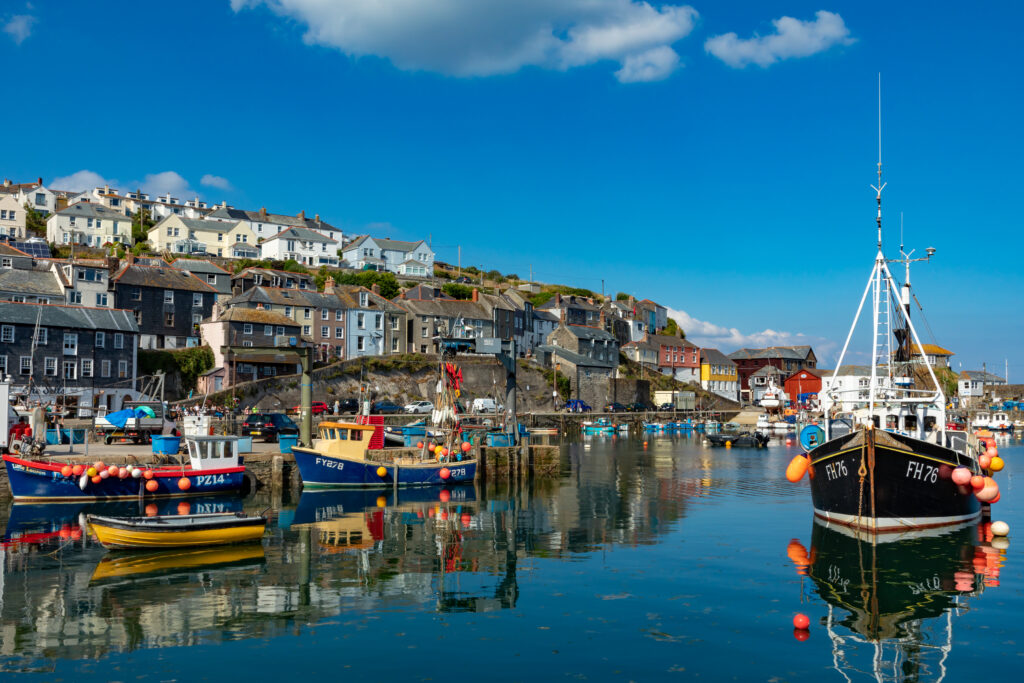
Mevagissey is a picturesque fishing village with narrow streets, colorful houses and a historic harbor. It is known for its authentic charm and traditional character.
The harbor of Mevagissey is a central port of call where you can watch fishing boats and buy fresh fish. There are also excursion boats offering trips along the Cornish coast.
The town offers a range of cozy pubs, restaurants and cafés where you can sample local specialties such as seafood and Cornish pasties.
There are several art galleries and craft stores where visitors can buy local artwork, crafts and souvenirs.
The area around Mevagissey is ideal for walking and exploring the stunning Cornish coastline. The South West Coast Path passes nearby and offers spectacular views.
Looe
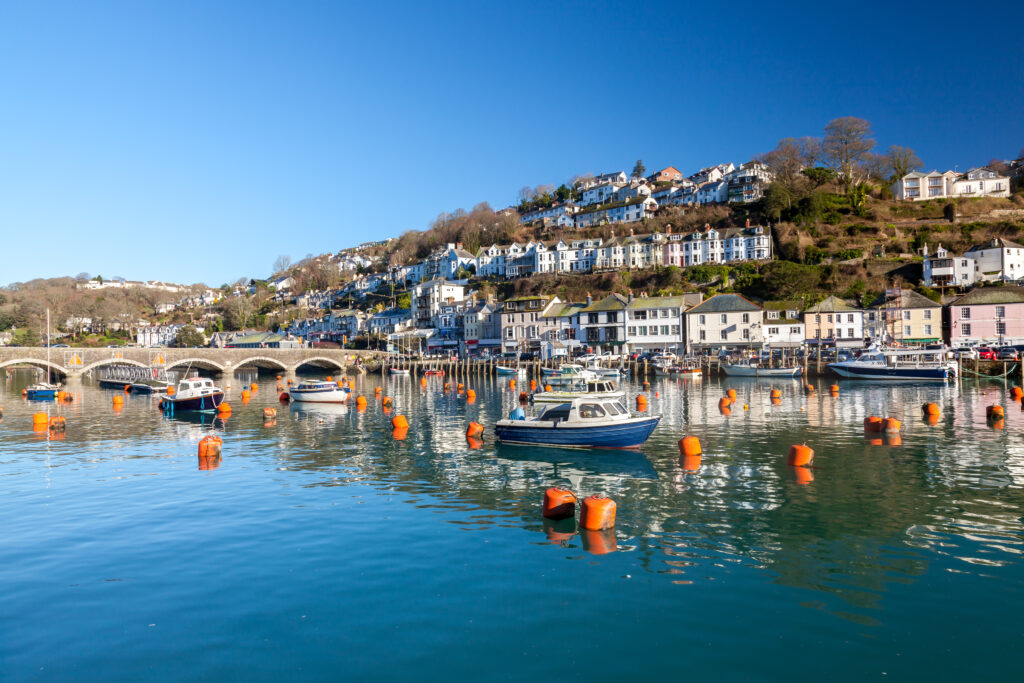
Looe is a lively coastal town with a picturesque harbor and a beautiful sandy beach. It consists of two parts, East Looe and West Looe, which are connected by a bridge over the River Looe.
Looe harbor is a busy place where you can watch fishing boats and buy fresh fish. There are also tour boats offering trips along the coast and river cruises on the Looe River.
The town has a selection of restaurants, pubs and cafes where you can enjoy local cuisine and seafood. The Looe Valley Vineyard nearby also offers wine tasting.
Looe is known for its festivals and events, including the Looe Music Festival and the Looe Lugger Regatta, which delight visitors with live music and entertainment.
For nature lovers, Looe offers stunning coastal scenery and the opportunity to walk along the coastal path or explore the nearby Looe Island Nature Reserve.
Fowey
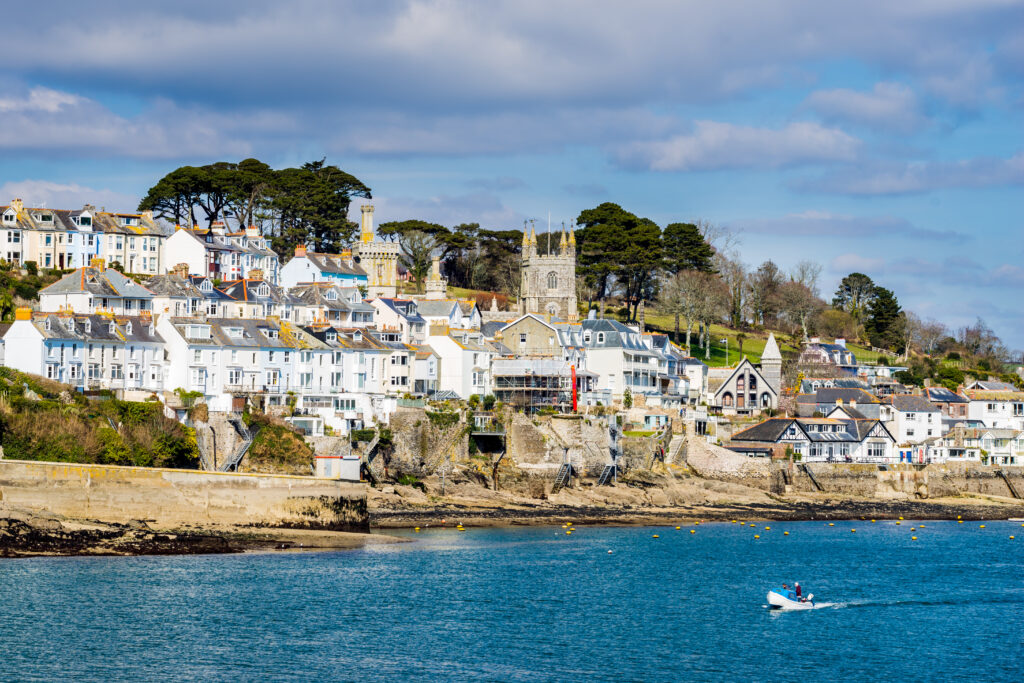
The enchanting fishing village of Fowey on the south coast of Cornwall nestles picturesquely against steeply sloping hills. The wildly romantic landscape consists of secluded beach coves, green meadows and a magnificent coastal path that seems to be just waiting for a visit.
A walk through Fowey and a visit to the famous Ferryside House will transport you to another world and is one of the most beautiful excursion destinations in Cornwall. You can look forward to very special picture motifs and an original fishing village that reveals the beauty of the region.
The fishing village of Fowey stretches an impressive 1.5 kilometers along the west coast of the river of the same name. Today, the town is not only a popular vacation and excursion destination due to its special beauty, but also an important seaport with a long history.
Polruan is a small fishing village on the south coast of the county of Cornwall in the southwest of England. The village is part of the civil parish of Lanteglos-by-Fowey and lies opposite Fowey on the east bank of the mouth of the Fowey River into the English Channel.
Lantic Bay is a hidden gem of a beach; beautifully horseshoe shaped, a sheltered bay with white sandy beaches and crystal blue waters. It can be reached in a few minutes from Fowey.
Falmouth
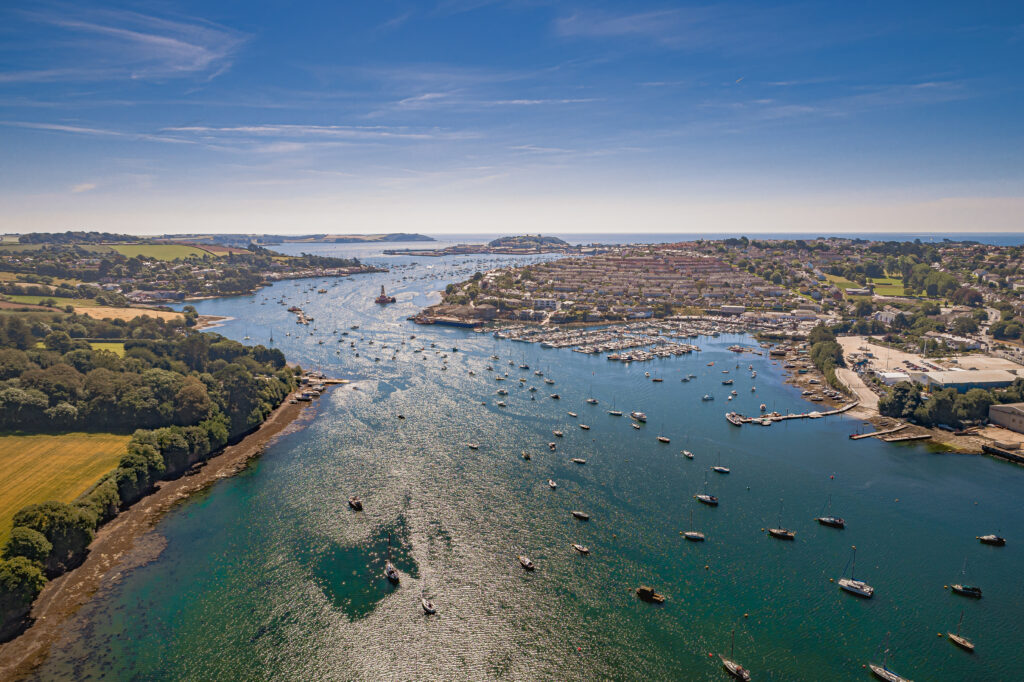
Blooming gardens in which exotic plants grow and flourish magnificently, palm trees and a mild, humid Gulf Stream climate have earned the coast around the port city of Falmouth the name “Cornish Riviera”.
Here, the southwest of England shows its most fertile, colorful side – and everything you thought you knew about the weather on the island suddenly seems completely outdated. Here, stately gardens are lined up one after the other, always seeming to outdo each other in lushness and color.
In the middle of this sea of flowers lies Falmouth, a town that seems to consist entirely of harbors. Those who come to Falmouth usually either want to visit Pendennis Castle or are interested in the National Maritime Museum of Cornwall, whose 29-metre-high tower overlooks the harbour.
Most visitors, however, are drawn to the sun: the parks of Glendurag, Trelissick and Trebah delight visitors with their Mediterranean-style flora, whose blaze of color is absolutely breathtaking, especially in May and June.

